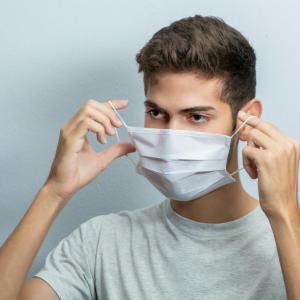You are here
We suspected that the best strategies to avoid catching a disease can change: And now we proved it.
24 May, 2024

“Keep 2 metres distance apart”, “Wash your hands”, “Avoid socialising”, “Wear a mask”, “Avoid children” or “Avoid vulnerable people”. That’s how you avoid catching Covid or giving it to other people, right? Or maybe it’s not so simple and consistent. Maybe the best behaviours for avoiding getting ill can change, even with a relatively new disease like COVID-19. That’s what we found with an analysis of risk factors and Covid-19 infection status data in 2021-2022, that's just been published here.
Data source
The UK Office of National Statistics (ONS) swabbed and surveyed a large number of people every two weeks for most of 2020-2022. The swabs tested for Covid-19. From November 2021 to May 2022 the survey asked people about their habits and potential protective or risk factors for testing positive and reported the positivity rate with those potential risk factors. The ONS sample was balanced for many demographic features such as deprivation group, geography, age and sex distribution. People (volunteers!) were tested by the ONS whether or not they had symptoms.
Methods
Lacking access to the primary data, we used a statistics method called meta-regression on the population data as published by the ONS. We also undertook an analysis for trend: we wanted to see if each risk factor had a consistent relationship with testing positive or if a risk factor changed over the November 2021 to May 2022 period. It was possible for instance, that a behaviour or factor that was initially protective became not protective or even tended to promote infection by the end of the period. We visualised the stability or changes in risk factors using ‘fir tree graphs’.
Results
In our analyses, some risk factors stayed the same across the period we looked at. For instance, women, people from ethnic minorities and disabled people were consistently were less likely to test positive throughout this period than other people. However, other risk factors changed. For instance, in November 2021 living in a larger household tended to mean that people were more likely to test positive, but by May 2022, living in a larger household meant about the same chances of testing positive as living in a single person household. Similarly, living with adults age 70+ or under age 16 years had variable associations with likelihood of testing positive.
One of the most interesting results the analysis yielded was that wearing a facemask (in enclosed spaces, at work or school, etc.) initially was associated with lower risk of testing positive. But especially, after February 2022, this apparent protective effect seemed to disappear.
Why?
Until now, this summary has been based on definite facts about the data, analysis methods & results. Trying to understand “why” risk factors change is trickier and leads us into speculation. We know that the Omicron variant became dominant in December 2021 in the UK, and that it was much more infectious than previous variants. It also seems to be associated with milder illness, and not just because by late 2021 most people already had one or more infections. Instead, Omicron itself was a bit different from previous variants. Omicron most targeted cells in the very top of the respiratory tract. As a result, people got symptoms sooner, with a shorter incubation period. The infection also tended to have less effect on the most critical parts of the lungs, which original ‘wild’ covid would especially affect. So because of where Omicron virus most targeted human cells, it had the potential to be a milder illness that spread more quickly and easily. Possibly, because the illness was often milder, people had a harder time knowing if they had it or were transmitting it.
What does that mean about future pandemic preparedness?
We shouldn’t be surprised that the best strategies for reducing harm during a public health crisis can change. Plus, not every ‘new virus variant’ is necessarily a scary new worse variant. Even before 2020, it was recognised that emerging microbial diseases tend to adapt to become more transmissible and more mild over time. We have seen exactly that happen with Covid. The change doesn’t make early pandemic advice (e.g. about social distancing or wearing a mask in indoor spaces) wrong, it just means that no set of advised actions is likely to be perfect throughout the entire course of an epidemic. Using improved understanding to see a better balance of actions is something that humans are good at and we should encourage, too, rather than worry about not getting it perfect from the start. So for instance, masks were inconvenient and never guaranteed protection, but they probably helped to delay infection for many people until safe vaccines had been developed. However, not least because Covid became so transmissible and widespread, masks were unlikely to stay particularly protective forever.




